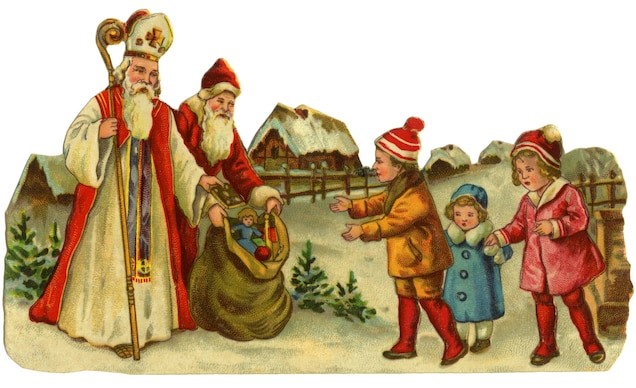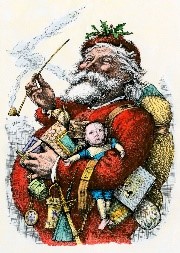
THE LEGEND OF SAINT NICHOLAS

Way back in the 3rd century, a boy named Nicholas was born in the village of Patara, on the southern coast of what is today Turkey. He had wealthy Christian parents who died in an epidemic while Nicholas was still young. His parent taught Nicholas to always obey Jesus’ words to “sell what you own and give the money to the poor.” Nicholas received a large inheritance when his parents died, and he used all of it to assist the needy, the sick, and the suffering.
Nicholas dedicated his life to serving God and was made Bishop of Myra while still a young man. Bishop Nicholas soon became known throughout the land for his generosity to those in need, his love for children, and his concern for sailors and ships.
Under Roman rule, Bishop Nicholas suffered for his faith, was exiled and imprisoned. The prisons were so full of bishops, priests, and deacons, there was no room for the real criminals—murderers, thieves and robbers.
After his release, Nicholas attended the Council of Nicaea in AD 325. He died December 6, AD 343 in Myra and was buried in his church, where a unique relic, called manna, formed in his grave. This substance was known to have healing powers, and so the people’s devotion to Bishop Nicholas grew even more after his death. The anniversary of his death became a day of celebration, St. Nicholas Day, December 6th.
Through the centuries many stories and legends have been told of St. Nicholas’ life and deeds. These accounts help us understand his extraordinary character and why he is so beloved and revered as protector and helper of those in need.
One story tells of a poor man with three daughters. In those days a young woman’s father had to offer prospective husbands a dowry. The larger the dowry, the better the chance that a young woman would find a good husband. Without a dowry, a woman was unlikely to marry. This poor man’s daughters had no dowries, and were therefore destined to be sold into slavery. But mysteriously, on three different occasions, a bag of gold appeared in their home-providing the needed dowries.
The first 2 bags were tossed through an open window and landed on stockings left before the fire to dry. When Nicholas was ready to throw the third bag of gold through the window, he found it closed and locked. And so, Nicholas did what we all would do … he climbed up to the roof and dropped the third bag of gold down the chimney, where it promptly landed on the shoes lying beside the fire below.
This legend led to the custom of children hanging stockings or putting out shoes, eagerly awaiting gifts from Saint Nicholas.
One of the oldest stories about St. Nicholas as a protector of children takes place long after his death. The town of Myra was celebrating the good saint on the eve of his feast day when a band of Arab pirates from Crete entered the town. They stole many treasures from the Church of Saint Nicholas. And, as they were leaving town, they snatched a young boy named Basilios, to make him into a slave. The pirate’s ruler selected Basilios to be his personal cupbearer, since he didn’t know the language and would not understand what the king said to those around him.
So, for the next year Basilios served the ruler. But Basilios’ parents were devastated at the loss of their only child. The year passed very slowly for them, filled with grief. A year later, when the next St. Nicholas’ feast day approached, Basilios’ mother would not join in the festivity, for it had become a day of tragedy for her. But she was persuaded to have a simple observance at home—with quiet prayers for Basilios’ safekeeping. Meanwhile, Basilios was fulfilling his tasks serving the ruler as his mother prayed, when suddenly he was whisked up and away. Then St. Nicholas appeared to the terrified boy. He blessed him, and then took Basilios back to his Myra home.
Imagine the joy when Basilios amazingly appeared before his parents, still holding the king’s golden cup!
Another story tells of three religious students, traveling on their way to study in Athens. A wicked innkeeper robbed and murdered them, hiding their remains in a large pickling tub. It so happened that Bishop Nicholas, traveling along the same route, stopped at this very inn. In the night he dreamed of the crime, got up, and summoned the innkeeper. As Nicholas prayed earnestly to God, the three boys were restored to life and wholeness.
In France the story is told of three small children, wandering while playing until lost, lured, and captured by an evil butcher. St. Nicholas appeals to God to return them to life and to their families.
Several stories tell of Nicholas and the sea. When he was young, Nicholas sought more of God by making a pilgrimage to the Holy Land. There as he walked where Jesus walked, he sought to experience more deeply Jesus’ life, passion, and resurrection. Returning by sea, a mighty storm threatened to wreck the ship. Nicholas calmly prayed. The terrified sailors were amazed when the wind and waves suddenly calmed, sparing them all. Thus, St. Nicholas also became the patron saint of sailors and voyagers.
Other stories tell of Nicholas saving his people from famine, sparing the lives of those innocently accused, and much more. He did many kind and generous deeds in secret, expecting nothing in return. Within a century of his death, he was celebrated as a saint.
Through the centuries, St. Nicholas has continued to be venerated by Christians worldwide. His example of generosity to those in need, especially children, continues to be the model for a compassionate life dedicated to God. And somewhere along the way, the Spirit of Saint Nicholas became known as Santa Claus.
Channeling my own inner-Saint Nick!
Pastor Bob <><

